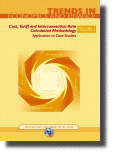
Trends
in Economics and Finance
Volume I: Cost, Tariff and Interconnection Rate
Calculation Methodology
and Application to Case Studies
This publication is aimed in particular at network operators
and regulatory authorities in developing countries who do not have very detailed
data at their disposal on their costs or on the development of prices in their
market.
-
The first part describes a model for the calculation of telephone service
costs, tariffs and interconnection taxes.
-
The second part shows how the application of this model in different
situations (case studies) allows for the identification of national political
demands concerning universal service obligations.
Foreword
The whole question of tariffs is crucial to the development of
telecommunications, since it is tariffs that will mercilessly make or break
anyone setting out in this sector. Negotiating tariffs or rates is hence a
delicate matter, whether for the new operator entering a liberalized market and
fearful of finding itself lumbered with excessively high interconnection
charges, or for the regulator wishing to set low tariffs for national calls
without compromising the rules of competition among the various operators.
The question is also a much debated one because the nature of the costs on
which tariffs are supposed to be based can differ greatly:
To what extent do they reflect the genuine impact of a causal relationship
with the volume of service provided?
Many other questions may be raised in this regard. Various cost concepts
exist and are formulated in models (LRIC, LRAIC, FLEC, TELRIC, TSLRIC, CCA, FDC,
etc.). Each concept presupposes the availability of a quantity of data without
which the results obtained would be no more than vague estimates, however
complex the models used.
For the purposes of this publication, a cost concept was deliberately chosen
that takes account of the data that may be found in almost all developing
countries. By implementing the principles set forth therein, a response may be
found to the following concerns:
-
calculation of costs and tariffs pertaining to urban and long-distance
telephone services;
-
calculation of costs and tariffs pertaining to international telephone
services;
-
calculation of settlement rates for incoming international calls;
-
calculation of interconnection charges between local telecommunication
network operators, whatever the origin and whatever the destination;
-
calculation and distribution of the cost of universal service
obligations;
-
determination of the impact of universal service policies and
formulation of associated policies.
The second part of the report sets forth the results emerging from typical
case studies carried out on the basis of the aforementioned principles (with a
view to serving as a methodological guide), as well as those produced by a case
study relating to aggregate data from eight African countries representing the
different situations prevailing there (with a view to providing mean comparative
values).
These case studies show, in real terms, how to address tariff rebalancing,
how such rebalancing affects or enhances service consumption, and the ways in
which it relates to the determination of other tariffs, bearing in mind the
desire on the part of States to protect underprivileged consumers.
The ITU-D membership, particularly members from developing countries, had called
for the publication of such a document, and it is our hope that what they find
in it will meet their expectations.
| Catalogue Price: |
CHF 50.- |
| Member States and Sector Members: |
- 15% |
| Administrations of Least Developed Countries: |
- 80% |
Electronic copy via Electronic Bookshop (No discount):
- http://www.itu.int/itudoc/itu-d/publicat/trendsv1.html |
CHF 50.- 
(English, French, Spanish and Russian editions are available) |
| To order hard copy, download order form via: |
Publication
notice free of charge |
|



